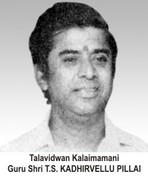Talavidwan Kalaimamani Guru Shri T.S. Kadhirvellu Pillai
1934-2001
Excerpts from 'Impressions of a master' by Smt. Prakriti Bhaskar, released on the occasion of his '1st Punyatithi' on 22nd November 2002“
Listen carefully this is Kadhirvellu sir's jati…”
This statement is enough to make even a seasoned dancer sit up and await the mind-boggling and challenging rhythmic virtuosity that was to unfold. Rhythm is the basis of dance. To Kadhirvellu sir it was the soul and seed of dance. And, it is this that he perfected in his simple life and undramatic career.
The Journey
Born in a traditional family of nattuvanars in a small village called Tirukokarnam in Tamil Nadu the seeds of his innate flair for rhythm were sown very early in his childhood. He began his career as a nattuvanar to many renowned dancers like Smt. Mrinalini Sarabhai, Smt. Sonal Mansingh, Smt. Asha Parikh & Smt. Yamini Krishnamurthy. He also served as a lecturer at Bombay Universities Nalanda Nrityakala Mahavidyalaya founded by the eminent dance personality Dr.(Smt) Kanak Rele. In the final phase of his career he taught a handful of students, most of whom where established dance teachers in Mumbai.
The style & method
His style was inspired by Guru Kittappa Pillai, another great master of Bharat Natyam whom he regarded as his 'manasik guru'. His style of composing was unique because the shollus or recitative syllables and the rhythmic dance patterns (expressed in the nattuvangam), did not move together but rather moved in a criss-cross pattern and seemed to merge only at the end of the tala cycle. It seemed as though the hand and the mouth played a game of hide & seek with each other only to be discovered at the end. This required a capacity of the tongue and hand to move in isolation & independent of each other, held together only by an alert, concentrated mind. He regarded tala training an indispensable part of the dance training & the basis for nattuvangam. He did not create dramatically innovative items. His work mainly consists of the traditional margam, but what he did to these conventional items was unique.
